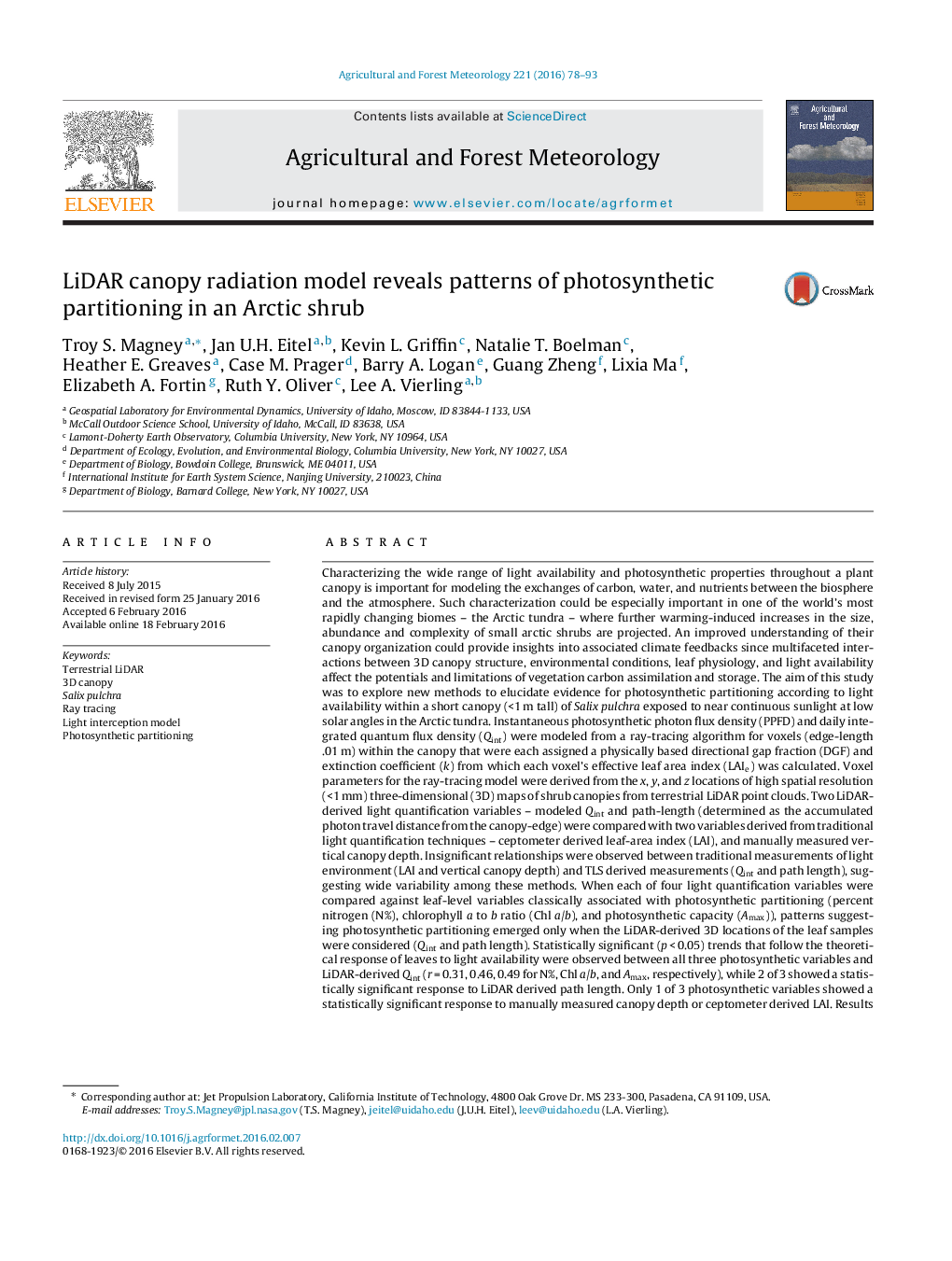| کد مقاله | کد نشریه | سال انتشار | مقاله انگلیسی | نسخه تمام متن |
|---|---|---|---|---|
| 81365 | 158312 | 2016 | 16 صفحه PDF | دانلود رایگان |

• Shrub canopy light regime was investigated with LiDAR and traditional techniques.
• Integrated quantum flux was determined from a LiDAR-based 3D canopy model.
• Wide variability in quantified light was observed between different techniques.
• Only LiDAR derived 3D light revealed patterns of photosynthetic partitioning.
Characterizing the wide range of light availability and photosynthetic properties throughout a plant canopy is important for modeling the exchanges of carbon, water, and nutrients between the biosphere and the atmosphere. Such characterization could be especially important in one of the world's most rapidly changing biomes – the Arctic tundra – where further warming-induced increases in the size, abundance and complexity of small arctic shrubs are projected. An improved understanding of their canopy organization could provide insights into associated climate feedbacks since multifaceted interactions between 3D canopy structure, environmental conditions, leaf physiology, and light availability affect the potentials and limitations of vegetation carbon assimilation and storage. The aim of this study was to explore new methods to elucidate evidence for photosynthetic partitioning according to light availability within a short canopy (<1 m tall) of Salix pulchra exposed to near continuous sunlight at low solar angles in the Arctic tundra. Instantaneous photosynthetic photon flux density (PPFD) and daily integrated quantum flux density (Qint) were modeled from a ray-tracing algorithm for voxels (edge-length .01 m) within the canopy that were each assigned a physically based directional gap fraction (DGF) and extinction coefficient (k) from which each voxel's effective leaf area index (LAIe) was calculated. Voxel parameters for the ray-tracing model were derived from the x, y, and z locations of high spatial resolution (<1 mm) three-dimensional (3D) maps of shrub canopies from terrestrial LiDAR point clouds. Two LiDAR-derived light quantification variables – modeled Qint and path-length (determined as the accumulated photon travel distance from the canopy-edge) were compared with two variables derived from traditional light quantification techniques – ceptometer derived leaf-area index (LAI), and manually measured vertical canopy depth. Insignificant relationships were observed between traditional measurements of light environment (LAI and vertical canopy depth) and TLS derived measurements (Qint and path length), suggesting wide variability among these methods. When each of four light quantification variables were compared against leaf-level variables classically associated with photosynthetic partitioning (percent nitrogen (N%), chlorophyll a to b ratio (Chl a/b), and photosynthetic capacity (Amax)), patterns suggesting photosynthetic partitioning emerged only when the LiDAR-derived 3D locations of the leaf samples were considered (Qint and path length). Statistically significant (p < 0.05) trends that follow the theoretical response of leaves to light availability were observed between all three photosynthetic variables and LiDAR-derived Qint (r = 0.31, 0.46, 0.49 for N%, Chl a/b, and Amax, respectively), while 2 of 3 showed a statistically significant response to LiDAR derived path length. Only 1 of 3 photosynthetic variables showed a statistically significant response to manually measured canopy depth or ceptometer derived LAI. Results from this study suggest that LiDAR-based techniques for quantifying the 3D light environment of small shrubs exposed to low solar angles reveal patterns of photosynthetic partitioning that may otherwise be overlooked using more traditional techniques.
Journal: Agricultural and Forest Meteorology - Volume 221, 1 May 2016, Pages 78–93